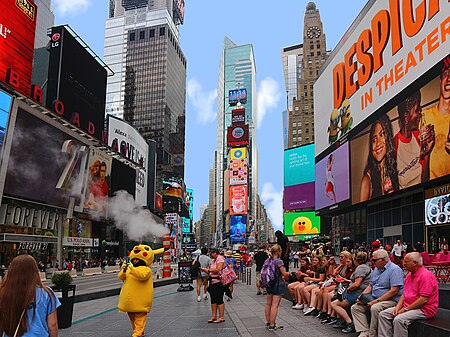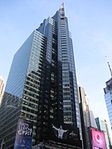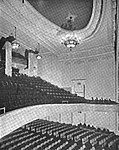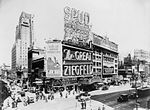1540 Broadway, formerly the Bertelsmann Building, is a 44-story office building on Times Square in the Theater District neighborhood of Manhattan in New York City. Designed by David Childs of Skidmore, Owings & Merrill (SOM), the building was developed by Broadway State Partners, a joint venture between Bruce Eichner and VMS Development. 1540 Broadway occupies a site bounded by Broadway to the west, 45th Street to the south, and 46th Street to the north. It was originally named for its anchor tenant, German media company Bertelsmann. The building is divided into two ownership units: HSBC and Edge Funds Advisors own the office stories, while Vornado Realty Trust owns retail space at the base.
1540 Broadway consists of a low base, as well as a tower section measuring 733 ft (223 m) to its spire. An outwardly projecting "prow" extends from the western side of the building. The facade is designed with large signs at the base, with a main office entrance on 45th Street. The upper stories contain a facade of blue and green glass with vertical aluminum mullions. There is a public passageway and about 150,000 sq ft (14,000 m2) of retail space at the base; the retail space was originally supposed to be part of a five-story shopping mall that was never opened. The basement formerly contained a four-screen movie theater, while the upper stories contain 860,000 sq ft (80,000 m2) of offices.
Broadway State Partners had developed 1540 Broadway on the site of Loew's State Theatre and several other buildings. Helmut Jahn initially proposed a mixed-use office, hotel, and commercial building on the site, though Childs subsequently drew up plans for an office building with retail at its base. Work started in 1988 and the building was completed in 1990, but it was completely empty for the next three years. Bertelsmann bought the building out of bankruptcy in 1992 and moved its headquarters there, opening several retail stores in the late 1990s. The Paramount Group bought the building in 2004, reselling the offices two years later to Equity Office Properties and the stores to Vornado. The offices were subsequently resold to Harry B. Macklowe in 2007, Deutsche Bank in 2008, and CBRE Group in 2009; HSBC and Edge acquired the offices in a two-part sale in 2010 and 2011.











